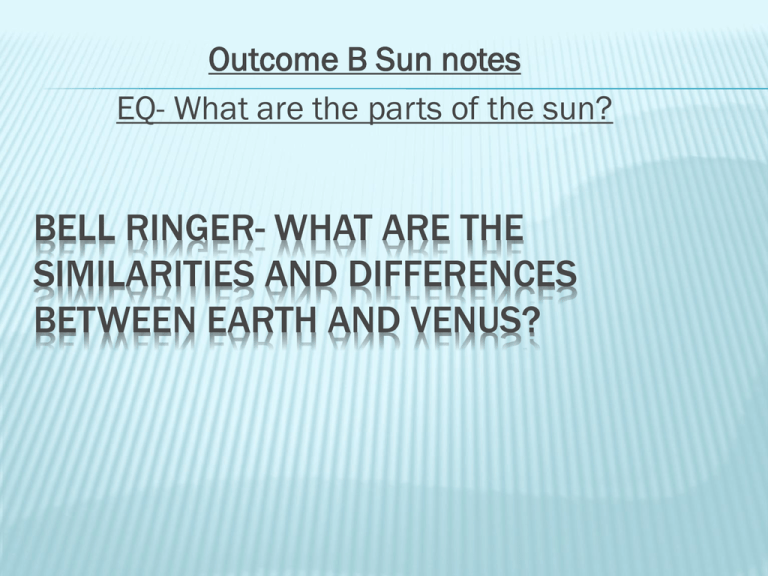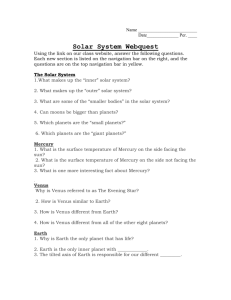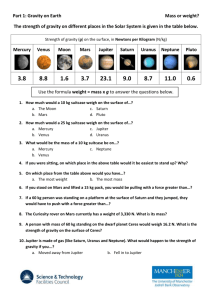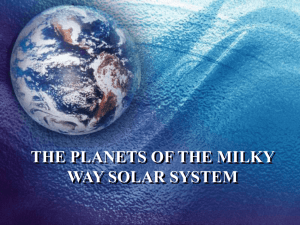File
advertisement

Outcome B Sun notes EQ- What are the parts of the sun? BELL RINGER- WHAT ARE THE SIMILARITIES AND DIFFERENCES BETWEEN EARTH AND VENUS? ANSWER: EARTH VS. VENUS Similarities Size Differences Venus rotates very slowly from east to west; Earth rotates more quickly from west to east Density Venus has a thick atmosphere that is mostly carbon dioxide; Earth’s atmosphere is mostly nitrogen and carbon dioxide Internal structure Venus is much hotter than Earth; Earth has liquid water on most of its surface REVIEW YOUR NOTES ON THE PLANETS Quiz starts in 5 mins When done with the quiz turn it in and read at your desk. KWL – WHAT DO YOU KNOW ABOUT THE SUN With your table create a list of things you know about the sun. Jobs1. Supply getter (white board, paper towel, expo marker) 2. 3. 4. Writer Reporter outer Supply returner POPCORN READ CH 3 SEC 2 THE SUN PAGE 68 Around your table number off 1-4 These are the answers you are looking for. 1. What are the layers of the sun? 2. How does the sun make energy? 3. What are the parts to an atom? 4. What is a sunspot? THE SUN A star Provides light and heat to Earth Made of hydrogen and helium About 4.6 billion years old PARTS REVIEWED When you see an image of the sun, you are seeing the photosphere The sun’s corona, which looks like a halo, can usually be seen only during a solar eclipse The middle layer of the sun’s atmosphere is the chromosphere Sunspots are darker areas of gas on the sun that are cooler than the surrounding gases LABELING THE SUN When you get you sun worksheet put your name on it. We will label together CREATE A SUN Your table will work together to create a sun with all it’s parts on the white boards. I will walk around and quiz you on the different parts. *IF TIME*MAGIC SCHOOL BUS CLIP Look for True facts that they include. You need at least 10. Use this has a review of your planet facts. Test is next week! CHEMISTRY BACKGROUND INFORMATION: An atom is the smallest particle of an element Atoms have a core, or nucleus, containing neutrons (no charge) and protons (+ charge) Electrons (- charge) surround the nucleus Nucleus: has neutrons and protons Electrons surround ATOMS Atoms can have a positive, negative, or neutral charge Atoms can change their charge by gaining or losing electrons When an atom gains an electron, it becomes a negative ion (an ion is an atom with an unequal amount of protons and neutrons) http://player.discoveryeducation.com /index.cfm?guidAssetId=265D5BABBE5C-4A58-8346EEA0D951E617&blnFromSearch=1& productcode=US THE PERIODIC TABLE: Lists all of the elements The atomic number is the same number of protons in the nucleus of an atom WHAT CAUSES THE SUN TO PRODUCE ENERGY? Nuclear fusion- the combination of the nuclei of small atoms to form a larger nucleus; releases energy Atoms are very active and crash into each other The nuclei become joined, releasing huge amounts of energy Nuclear fusion occurs in the core, or center, of the sun WHO CAN NAME THE PLANETS THE PLANETS: Mercury Venus Earth Mars Jupiter Saturn Uranus Neptune My Very Educated Mother Just Sent Us Noodles Mercury Jupiter Venus Saturn Earth Uranus Mars Neptune INNER PLANETS: Small Rocky surfaces Mercury, Venus, Earth, Mars MERCURY Only inner planet that DOES NOT show evidence of volcanic activity Smallest terrestrial planet VENUS Known as the “morning star” and “evening star” Earth’s twin due to size and density Retrograde rotation meaning that it rotates opposite of Earth Pressure is 90 times greater than on Earth Atmosphere traps heat from the sun causing a “greenhouse effect” EARTH One of the conditions required for life on Earth is liquid water EARTH VS. VENUS Similarities Size Differences Venus rotates very slowly from east to west; Earth rotates more quickly from west to east Density Venus has a thick atmosphere that is mostly carbon dioxide; Earth’s atmosphere is mostly nitrogen and carbon dioxide Internal structure Venus is much hotter than Earth; Earth has liquid water on most of its surface MARS May have had conditions needed to support life because there is evidence that liquid water was once present Spirit and Opportunity rovers found clear geologic evidence of ancient streams, lakes, or floods Ice is present at the polar ice caps Large amount of water exists as a gas in the atmosphere Because the atmosphere is too thin, water cannot exist as a liquid Atmosphere is mostly carbon dioxide ASTEROID BELT Located between Mars and Jupiter Too small to be considered planets OUTER PLANETS: “Gas Giants” Composed mainly of hydrogen and helium Atmospheres of the gas giants cannot escape into space because they have very strong gravitational pulls Jupiter, Saturn, Uranus, Neptune JUPITER Largest and most massive planet “Great Red Spot” is a huge storm SATURN Rings are mostly made up of chunks of ice and rock Only planet that has a lower density than water URANUS Different from most other planets because it rotates on its side NEPTUNE Astronomers predicted the existence and orbit of Neptune based on Neptune’s gravitational effect on the orbit of Uranus Very similar in size and color to Uranus WORK CITED Wegner Notes NATIONAL GEOGRAPHIC ARTICLE http://news.nationalgeographic.com/ne ws/2011/10/111010-uranus-planetstilted-impact-double-blows-moons-spacescience/






